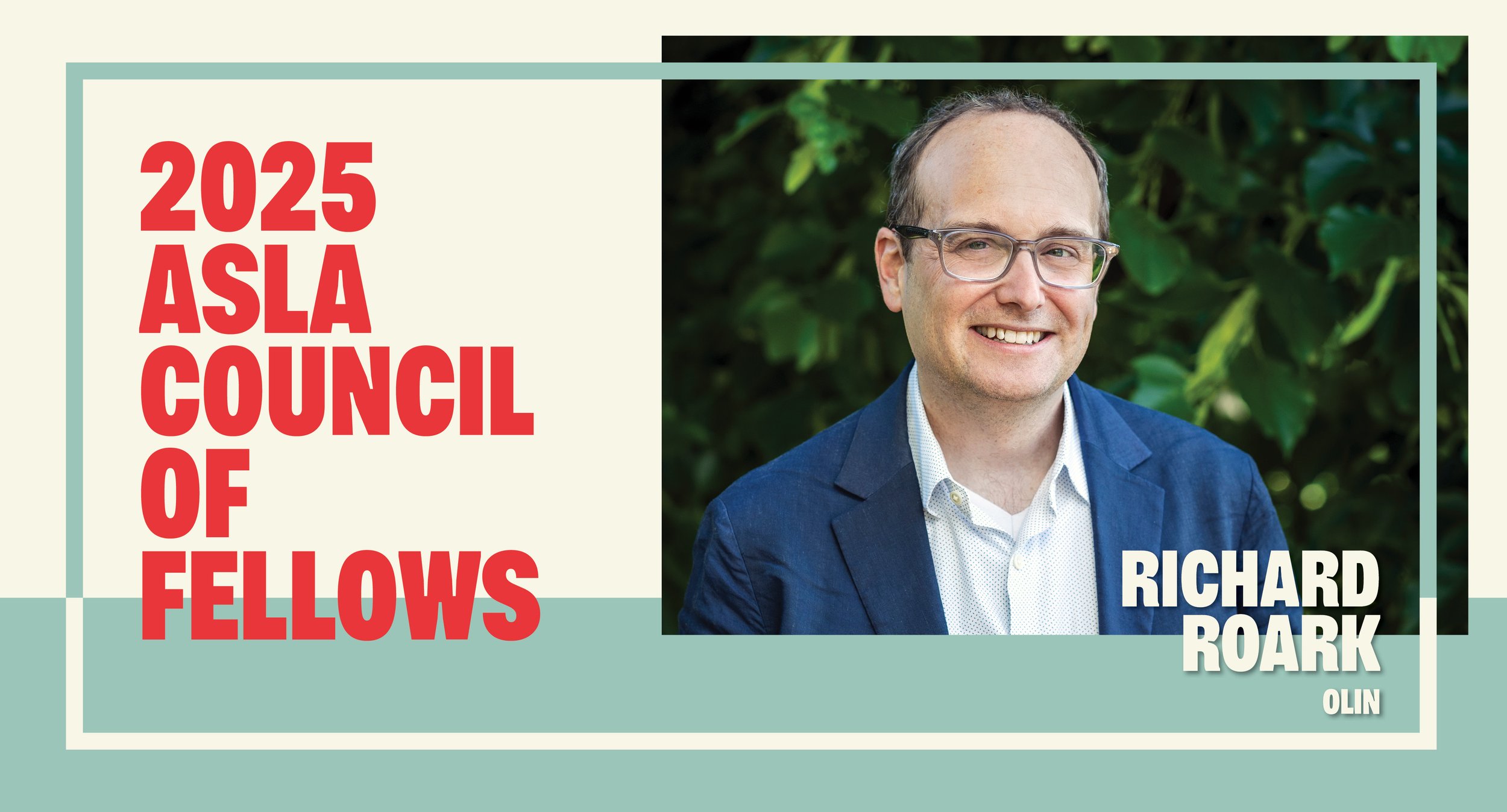Richard's "Good Morning" emails reliably fill the OLIN inboxes by 8:00AM on a daily basis. It’s a practice he initiated during the pandemic as a way to both reflect and stay meaningfully in touch. Whether he’s on site covering a new installation, in a fabricator’s workshop, or simply exploring the landscape for inspiration, he hits ‘send’ on this regular communication—to surface and dissect small wonders and big questions, and stimulating a conversation about practice, reverence for nature, and common humanity. It’s how Richard has both embraced and modeled the open studio culture of OLIN.
A leading voice in the firm, Richard became a Design Partner in 2012 and has used this position to bring landscape architecture into unexplored and unconsidered territories in design. From coastal and urban areas confronting climate change to social justice initiatives and circular economy research involving soils and broad-scale infrastructure corridors, he transforms diverse landscapes with equal expertise. Whether working on industrial sites and reclaimed quarries, urban plazas and university campuses, botanical gardens and riverfront parks, or informal settlements and agricultural landscapes, he partners with public housing authorities and top-tier institutions as well as small grassroots communities. Richard’s work seeks to help people find their agency in their geography, he celebrates beauty and potential in the world's complexity, and cultivates lasting vitality.
Richard looks deep within himself, the profession, and community to cultivate purpose for OLIN and our shared community of practice. When invited to consider the role of Chief Strategy Officer (CSO), his response was, “Why?” Richard was not being cheeky, this is how he operates. He continued, “strategy doesn't come with the assumption of any kind of steering wheel per se. You’ve got to understand your objectives first, and then you figure out what's the best way to get there with your strategies.” In considering the objectives, he starts by examining the “Why” because he is interested in the purpose. “People are at their best when they know the work we’re a part of is making change in the world—for a better environment, stronger communities, and that fits our credo to ‘create places that enhance life.’ But that’s not a static position. It’s something you have to figure out every day.”
As Chief Purpose Officer, Richard wants to inspire us to practice the habit of asking “Why?” Engaging others with this provocative curiosity, he will continue the practice of cultivating OLIN’s purposes as a multi-faceted consideration—of everything from our office culture to living systems to communities we serve. In an effort to sustain the zeitgeist of OLIN he also asks, “How are we staying authentic?” He knows that as we continue our success as a multi-generational organization, it is a ‘grass roots’ proposition; we will continue to grow leadership and accountability by expanding and distributing it among those “who are really interested, who have the magnetism and focus to take something further.”
Richard carries a torch lit by our CEO and President Lucinda Sanders, who says, “our success is that we are innovators, we are unafraid to speak up, we are tackling some of the most difficult problems of human civilization. In the context of a strong business model…it’s how we are able to contribute what is the highest and most innovative level.” Sanders reflects, “These are all things that come back to our founder Laurie Olin—he was curious about the world and he put time into it by studying it and drawing it. It was how he figured things out .This has become the ethos of OLIN.” Of Roark, she says, “He exemplifies this aspect of our practice. He’s always thinking about the next thing…is there a better way to try something, what should we be looking at?” On the topic of leadership, Sanders further reflects, “He is very empathic, and I have to say I don't think I ever want to see leadership here that is not. Ego-led leadership does not work in an organization that is built on a platform of inquiry and collaboration.” She knows Richard will discover and create his role out of things he believes are important for the future of OLIN, leading with intelligence, curiosity, and passion. And Richard will bring others along through a consistent demonstration of his strong value system—an unfailing sense of compassion and duty to our planet which he describes as a “long-term paradigm shift …less heroic or point-focused” and more about “ecological possibility, understanding of economy and health, and the instrumentality of landscape architecture.”
Today, Richard’s purposeful practice is embodied in nationally significant work at Sojourner Truth State Park in New York, ResilienCity Park in Hoboken, and Caño Martín Peña in San Juan. His leadership at Marie Selby Botanical Gardens has garnered recognition as well, earning OLIN the 2025 Philip Hanson Hiss Award, which celebrates pioneers of innovative modern design. The award honored OLIN’s work on the Botanical Garden Master Plan and Phase 1 Welcome Center, a vision shaped under Richard’s guidance. His elevation to the American Society of Landscape Architects Council of Fellows will be recognized at the 2025 National ASLA Conference as both a personal milestone and an affirmation of his lasting influence on the field.
With insight, compassion, and vision, Richard Roark continues to lead by example—challenging and inspiring those around him to shape a more equitable, ecologically vibrant, and purposeful world through landscape architecture. He is not only helping to define the future of the profession, but also ensuring that OLIN’s enduring mission is carried forward with authenticity and heart.


